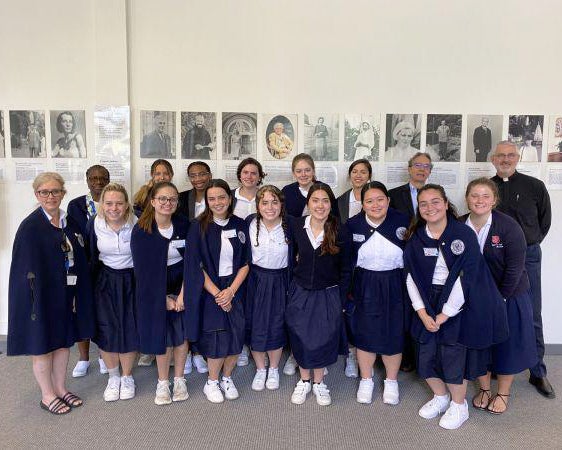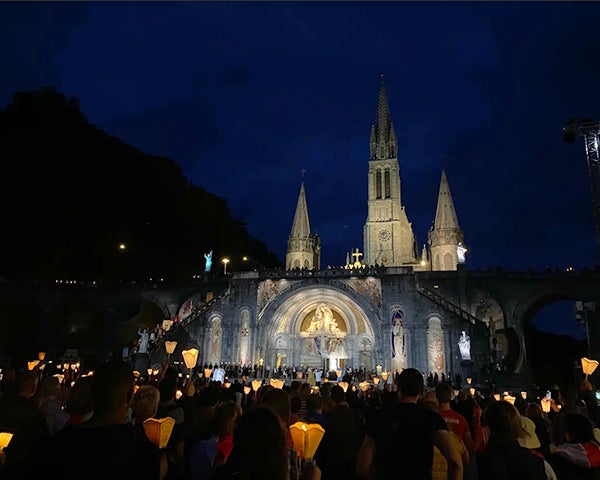Georgetown Nursing Students Focused on Spiritual Health of Pilgrims in Lourdes, France

Posted in GUMC Stories | Tagged Berkley School of Nursing, nursing, service to others
(July 1, 2022) — Carrying on a Georgetown tradition of helping pilgrims seeking a healing experience at the Sanctuary of Our Lady of Lourdes in France, 13 rising junior and senior nursing students put cura personalis into practice this summer by focusing on the spiritual care of those who traveled to the holy site from around the world.
The Georgetown-sponsored trip, May 28 through June 7, is part of the Lourdes Magis Immersion Program.
“The Lourdes trip is extraordinarily relevant to nursing practice,” said Madeline Prassas (N’23). “Nursing is so spiritual. People tend to look past that, but having good spiritual health can provide patients with a lot of comfort, especially with end-of-life care.”
For some students, the experience revealed a new way of relating to future patients.
“I was not raised very religious, but I feel way more comfortable talking about faith and spirituality with patients after this trip,” said Diana Tran (N’24).
“We talked a lot about what spiritual care means. It can be performed just through presence, just through being there for someone by sitting down with them and looking them in the eye, and asking what they need,” she added.

Importance of Spiritual Care
Sarah Vittone, DBe, RN, assistant professor of professional nursing practice, who accompanied the students to France, said the role of spirituality in patient healing is supported by research.
“The importance of spiritual care has been studied,” she said. “A large percentage of patients indicate a need for spiritual support by their nurse, and yet nearly the same percentage of nurses feel unprepared to provide spiritual care.”
“In Lourdes, students and faculty serve the pilgrims from around the world who come to participate in the religious ritual of bathing in the healing waters,” Vittone added. “The focus of this service immersion is blending cultural humility and spiritual care.”
Preparing Through Prayer and Film
After students applied and were interviewed for the 13 slots on the trip, Georgetown nursing faculty met with them every other week for five months to prepare for the activities they would engage in during the immersion trip.
“We look for students for the trip who had prior experience working in the community, especially with older adults,” said faculty advisor Edilma Yearwood, PhD, RN, PMHCNS-BC, FAAN, chair of the department of professional nursing practice. Yearwood, along with Vittone and Rev. Jerry Hayes, SJ, director of Ignatian programs, accompanied the students on the trip.
“We prepared in the months prior to travel with a focus on self-care, communication, compassion, health equity, moral courage, resilience and wellness,” Vittone said.
As an additional part of their preparation, the nursing students learned prayers in multiple languages and gained more insight into the history of the Sanctuary Our Lady of Lourdes by watching the 1943 film “Song of Bernadette,” which recounts the story of Bernadette Soubirous, who experienced 18 visions of the Virgin Mary in the mid-19th century.
Helping Others Complete Their Pilgrimage
“There was no set itinerary, we were sent by the Hospitale to where we were needed that day, whether it was to the baths or the train station,” Prassas said.
“One train we helped unload was filled with 150 sick people from Germany who had traveled 15 hours to Lourdes,” she added.
Tran found the train station to be an overwhelming vision. “You walk in and half of the station is just filled with wheelchairs waiting to be used by people who need them to get to the baths,” she said.
Before the pandemic, up to 40,000 visitors a day descended on Lourdes. While the Georgetown students were present, approximately 7,000 pilgrims still came every day.
“There were pilgrims from England, Italy, France, Germany, one group that traveled all the way from Mongolia,” Prassas said.
The Georgetown students were required to wear a uniform of a white scrub dress and a gray cape that Georgetown provided.
“We looked professional wearing our uniforms and we drew a lot of attention to ourselves, which meant people came up to us and asked a lot of questions like, ‘Where are the baths? Where are the sanctuaries?’” Prassas said.
“At the baths, we did the fundamental gestures with the pilgrims that Mary told St. Bernadette to do — wash your face, wash your hands, and drink the water,” she explained.
Science and Spirituality
“The sick, the malades in French, always come first in Lourdes,” Prassas said. “The sick are always at the front of processions, at the front of ceremonies. They are constantly involved with everything.”

Every night in Lourdes there is a torchlight procession, as well as a town mass on Friday evening that thousands attend.
“Despite being surrounded by so many sick people, there is so much hope,” she added.
The hope is driven by the Lourdes waters — widely believed to be responsible for medical miracles. The Medical Bureau of the Sanctuary, led by Alessandro de Franciscis, MD, investigates claims of miracle cures to determine whether a medical explanation exists.
Meeting de Franciscis was one of the highlights of the trip for both Prassas and Tran.
“He showed us a case study of someone who had a large sarcoma on their hip before visiting Lourdes, and after visiting, the X-rays showed the hip had healed,” Prassas said.
“He really showed how you can be a science believer and you can be a believer in faith and hope and miracles,” she added.
Spiritual Nursing as a Calling
“The students really connected with the concepts of humility and caring for those who are vulnerable, and those seeking hope in their health journey,” Yearwood said.
Kimberly Jolie (N’23) summed up many of her classmates’ feelings about the trip.
“I didn’t really know what I was going to take away from these 10 days, but I found that I was reminded of the reasons I was pursuing nursing in the first place,” she said. “Assisting someone through vulnerability and pain is the true gift of providing care.”
Heather Wilpone-Welborn
GUMC Communications
